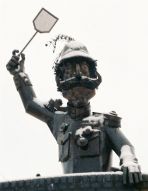
- typeset
- Touch Typist
 Offline
Offline - Registered: 24-4-2016
- Posts: 182
Triumph Gabriele 35
I am considering buying one, but wanted to know if it is similar to the Adler J5, which doesn't impress me. I understand it's basically an Adler, but would like to hear opinions. Thanks.
Visit my website, eafeliupoetry.com, for posts on typewriters and literature.
- TypewriterKing
- Inactive Account
 Offline
Offline - From: DeepInTheHeartO', Texas
- Registered: 17-2-2016
- Posts: 1,011
Re: Triumph Gabriele 35
I think it's well worth having two machines like that. I have a Smith-Corona and a Tower--two slightly different iterations of the same thing. I also once serviced a Tower upright--basically an Underwood in disguise. It looked almost identical to my Underwood Touch-Master II.
Underwood--Speeds the World's Bidness
- retro
- Platen Punisher
 Offline
Offline 
- From: Suffolk, England
- Registered: 11-2-2015
- Posts: 66
Re: Triumph Gabriele 35
It is an Adler and if you are unimpressed with the J5 then you are unlikely to be impressed with the Gabriele 35. I have Gabriele 25 too, which is the same machine without the touch control and go faster chrome carriage ends. It was voted best buy by Which magazine in 1975. I like mine and I only paid £5 for it. I find it a comfortable and fast machine with a nice smooth carriage but then we are all different and the keyboard might not suit some people.. If you don't like the J5 then I might be best to give the Gabriele 35 a miss.
- typeset
- Touch Typist
 Offline
Offline - Registered: 24-4-2016
- Posts: 182
Re: Triumph Gabriele 35
I ended up buying it and love it! Much better machine, in my opinion, than the J5, though they have the same feel. I especially like the elite typeface.
Visit my website, eafeliupoetry.com, for posts on typewriters and literature.
- •
- Uwe
- Moderator
 Offline
Offline 
- From: Toronto, Canada
- Registered: 12-3-2013
- Posts: 4,410
Re: Triumph Gabriele 35
typeset wrote:
Much better machine, in my opinion, than the J5, though they have the same feel.
Then what is it about the machine that makes it much better? I've found that you have to use later Triumph and Adler models (into the T-A era) for some time before passing judgement on their performance as their type actions takes some getting used to.
The pronoun I has always been capitalized in the English language for more than 700 years.
- TypewriterKing
- Inactive Account
 Offline
Offline - From: DeepInTheHeartO', Texas
- Registered: 17-2-2016
- Posts: 1,011
Re: Triumph Gabriele 35
Uwe wrote:
typeset wrote:
Much better machine, in my opinion, than the J5, though they have the same feel.
Then what is it about the machine that makes it much better? I've found that you have to use later Triumph and Adler models (into the T-A era) for some time before passing judgement on their performance as their type actions takes some getting used to.
Allow me to put this into the mix: You can put two typewriters that were completely identical--with the last digit of their serial numbers being only 1 apart--side by side--and there will be differences. When new, these differences will be minute to the point of being unnoticeable. Forty, fifty, sixty, and even seventy years or better later, the differences will be infinitely more vast. For instance, one typewriter will have a much stiffer touch than the other, or the print quality will not be as good on one as the other.
Now, same situation--only two machines identical except the badging. When new, there may be a few more differences, since the time they were made and the assembly lines they were on (though even here they could be one made just after the other on the same assembly line--not unheard of) may have been different. But, as I've said before, these differences will become greater as time goes on, since different people will have owned these typewriters, and have maintained them and used them quite differently.
So who is to say which one is better? And what exactly constitutes "better?" It could be said one may be cleaner and have had better maintenance than the other. One could have a better print, or a better feel than the other. Or one could merely look better--or at least less weathered.
In my 35 years of tinkering with these critters, I have found that "better" is not always objective. A short or standard carriage length typewriter, brand new-looking that has been well-maintained, may not necessarily be "better" than the typewriter with the longer carriage that has not been so well-cared for, when one considers needing a machine to type larger, nonstandard projects. However, the latter machine will need to be in at least reasonable enough shape to be able to handle the job.
Underwood--Speeds the World's Bidness

 1 of 1
1 of 1